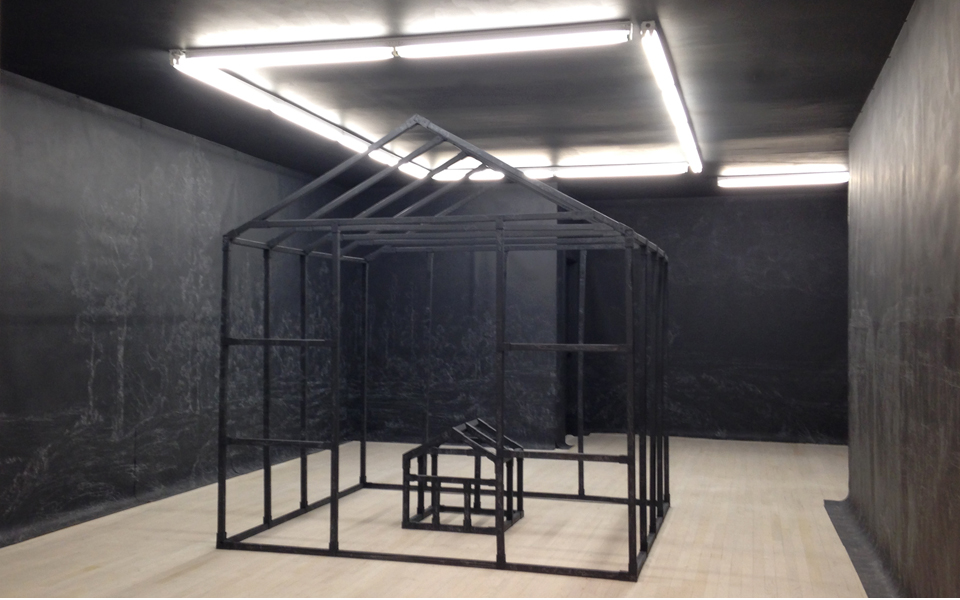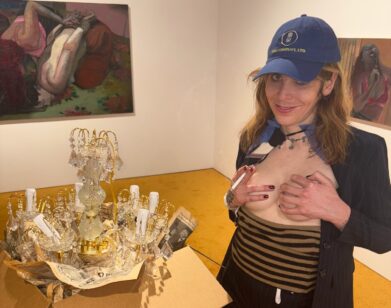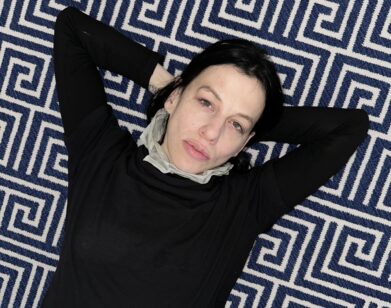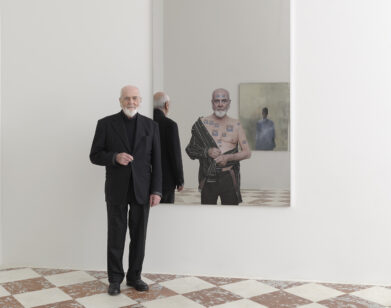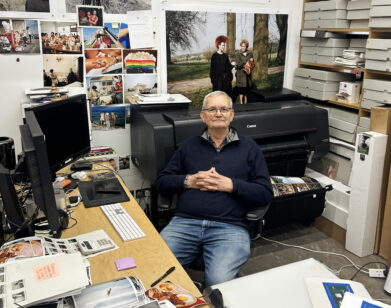Kysa Johnson’s Atomic Art
Some artists struggle to make sense of their work, but Kysa Johnson has hers down to a science. The 39-year-old artist draws with graphic renderings of micro-structures, often taken straight from science textbooks, to illustrate the macro-worlds encasing these undetectable forms. She will outline, say, asexually reproducing yeast, repeated over and over in variations as she sees fit, to represent something identifiable and conceptually related—in the case of the yeast, Renaissance paintings of the Immaculate Conception.
One theme she’s revisited depicts the most fundamental of the infinitesimal: subatomic particles—specifically, their decay patterns, from unstable to stable, mapped out over time. To the atomically illiterate, these look like spirals, waves, or loops, intercepted with slightly curved projectiles, sprinkled with Greek letters and numbers. When Johnson first learned of the models in art school, she saw their steady rhythm as poetic, and a “way to understand the world.” Sketched out with these notations, subjects contain their own inevitable disintegration, shivering with a common infrastructure.
Sourced from complex physics theory, the diagrams denote a simple universal truth: everything ends. The artist, contemplating this, has used them to represent social decline and change. Chalk on blackboard paint is her preferred medium, both for its high-school science-class associations and its implications of ephemerality. At last year’s Armory Show, Roman ruins after a Piranesi drawing materialized on the blackboard walls of faux Bank of America waiting room; a 2011 installation at Dublin Contemporary constrasted an Irish megalithic tomb to incomplete construction projects, symptomatic of the Irish economic collapse.
In her latest show at East Hampton’s Halsey McKay gallery, patterns, rendered in chalk on the gallery’s walls, swarm into an arboreal local landscape, spinning a tale of rich and poor, in past and present. On the left is a pre-colonial wigwam; in the center is a humble 16th-century estate, which inspired the unpretentiously spirited “Home, Sweet Home” song by John Howard Payne; on the right is billionaire investor Ira Rennert’s 110,000-square-foot mansion, the largest home in America. In the center of the gallery, two steel beam structures depict a small house in a large one; the difference in size represents the difference in wealth discrepancy—according to how much money the richest one percent of the population controls—in colonial times versus today. That would be a 344 percent increase, by the way, from 11.9 to 41 percent.
Johnson was born in Evanston, Illinois, and graduated from the Glasgow School of Arts. She now works in Bushwick, Brooklyn, where we met at her studio.
RACHEL SMALL: I know you are working with this subatomic particle pattern. How did you come by it?
KYSA JOHNSON: I’ve been using these marks since art school. I was always interested in science. I had an amazing chemistry teacher my sophomore year of high school. I was brought up Mormon until I was 13. I left [the church] at 13, because I had questions, I had divorced parents, all of these things were not working out. At the same time I had this science teacher, Mr. Francis, who really made me see science as a way to understand the world and how vast and amazing the world is. It was basically the feeling that I’m sure some people get from religion. “This makes sense because things are actually based in reality, things are actually amazing!” That was something that stuck with me forever.
When I went to went on my year abroad at the Glasgow School of Art, I was supposed to be there for a year [visiting from Skidmore]. But it was such an enlightening experience for me, and so challenging. I came to this place and I was so out of my league. It opened this world of ideas, and how to look at things, and I couldn’t leave. So I transferred. In my final year in Glasgow, I didn’t know what I wanted to talk about [in my art]. I was experimenting, and at the same time I was reading all these pop science books on quantum physics—cheesy ones, Fuzzy Thinking, The Tao of Physics. Whatever I could get my hands on. They ranged from more hard science to more philosophical.
Anyway, I came across these images of subatomic decay patterns, which are when [particles are] unstable. So there’s stable subatomic particles—protons, neutrons, electrons—and then there’s unstable ones that decay into stable ones. One will become many. There’s this constant process of transformation that underlies everything in the entire universe. They also make these beautiful marks through time. Here I was studying drawing and painting, and thinking about art-making, and here was mark-making that makes the universe. It’s like the universe was drawing, essentially, at this fundamental level. And it brought my two loves together. I stole the marks, basically. [laughs] Eleven basic marks.
SMALL: “Appropriated.”
JOHNSON: [laughs] Appropriated. They became my alphabet. So I started drawing them over and over and over again, trying to create this sense of speed and air congealing in some areas into mass.
SMALL: You’ve worked with this for a long time.
JOHNSON: It’s so natural to me now, that it’s almost hard to not… use. I wouldn’t know how to draw something without using [the patterns] now, almost. But that eventually led to using other alphabets to build up other things. Like [the 2011 series after the Hudson River School paintings], the shapes aren’t subatomic decay patterns; they’re the molecular structure of different environmental pollutants. This way of working for me has continued, but it’s like transferred sometimes to other series. So there’s always an alphabet that’s based in natural patterns. Sometimes they’re just by themselves, sometimes they build up these other things that relate to the conception, that are more at our level of existence.
SMALL: So it’s playing a lot with micro and macro scale, and interchanging those.
JOHNSON: Definitely. I kept looking up systems I could find, or processes, that repeated across scales. Like the human scale, or the nature scale.
SMALL: You mentioned you feel compelled to tie the conceptual loop together. Can I ask why that’s important to you? I’ve interviewed several artists, who are doing their thing, and it’s great, but they get this sort of roar from the art world, “Explain this to us!” Has that been your experience at all?
JOHNSON: For me it was more internal. [Without the conceptual element], it was almost having too much fun with something. [laughs]
SMALL: You’re like “This can’t be work!”
JOHNSON: I think my love of science comes from an interest in wanting to understand the world and wanting to understand our place in it. I need boundaries to work. I think I also wanted a way to talk about [microscopic versus macroscopic scale]. It’s also about working through ideas, challenging yourself in different ways. Glasgow was very much about ideas. I think that really formed the way I approached things. It was a way for me to have more of that, because I think that’s what I responded to there. I know that the idea is always to seduce aesthetically to reveal the idea. Because I think that, for me, is the most important part of it. It may not be for everybody else. But if I can hook, and reveal, and then, show something, illuminate something about the world, then that’s important to me.
SMALL: I feel like this is a very literal illumination of “things you can see”!
JOHNSON: Totally straightforward! My titles are always totally straightforward; it’s exactly what you’re looking at. Sometimes I’m like, “I feel more poetic!” But sometimes the reality is so poetic, why embellish it?
SMALL: How do you see these as poems?
JOHNSON: This is probably the most basic scientist answer: they’re elegant and beautiful and functional. They’re happening everywhere, all the time. They’re crazy looking, these curlicues, determined by the charge, and the mass. I think there’s constant movement through patterns, and there’s sort of this idea of being solid, which of course we’re not—everything’s fluid. There’s also something dark about it—everything is constantly falling apart and changing. What I’ve been doing now, after the installation at Halsey McKay, is using the subatomic decay patterns to build up dying stars. It’s the idea of bringing the two extremes together, in two kinds of death, or transformation. It’s about beauty, but it’s also accepting the inevitability of dissolution, of anything. It’s just how it is.
That plays into the Halsey McKay show. The unifying pattern is the subatomic decay patterns, and it is about the dissolution of an ideal, or a system over time. These have become the elements in the larger installations that I’ve done, using them, that are about the passing or collapse of something, basically.
SMALL: At last year’s Armory Show, were the Roman ruins superimposed on the Bank of America waiting room a suggestion that our civilization is crumbling?
JOHNSON: Yes. Everything crumbles. Here’s the collapse of great system; here’s a collapse of a great system. It was a collapse at all of these levels, a physical level, a fundamental level, a systematic level, a historic level. It was a way of saying that, but also saying that civilizations all don’t last. Maybe [the financial collapse] is the harbinger of that, but even if it’s not, it will fall [eventually]. But also it’s just such a basic image, where it’s just ruins, and decay and Rome. Everyone can relate to the fall of Rome.
SMALL: But it’s not terrible, because when Rome fell, it gave starts to new things.
JOHNSON: That’s what it’s saying too. To me, it’s not necessarily bad, it’s just how it is.
SMALL: It’s an undeniable truth.
JOHNSON: Yes.
SMALL: Like subatomic particle decay.
JOHNSON: Exactly! That’s how it goes. It’s an acceptance of that, and a looking at that. Wouldn’t everyone feel so much better if we were like, “Yeah, we’re not going to be so great, always”?
SMALL: Your style has remained consistent throughout your career. Do you ever see it changing?
JOHNSON: No. I don’t want it to. I feel like I’ve made an effort to distance myself from my work in a way, so that could be a factor of that as well. By bringing in these other conceptual elements that organize, it’s removing me just going, “Oh, this looks great here, and let’s do this here.”
SMALL: I feel like it leaves less to chance.
JOHNSON: There’s an anchor that’s tangible.
SMALL: I feel like you just need to complete the logic of your work, in a way. Which is great, because a lot of people try to wrap their heads around art. Having something tangible makes it easier to think about. These microscopic patterns show that your subjects are the same, but different… different, but the same.
JOHNSON: I’m not trying to create an aesthetic that’s my own; I’m trying to create a way understanding things through drawing and painting. That’s the common thread. Things can look different, but that’s not what’s important. What’s important is the process is the same, the ideas are the same, I’m using the same building blocks, but they’re different. The larger framework is the same; it’s the pieces that change. For me, it’s about these different elements, but you’re still fitting them together into sentences, words, paragraphs, and stories.
SMALL: I feel like that’s why scientists went looking for these particles in the first place, because they’re trying to make sense of the world.
JOHNSON: [In the works], you can see the shapes. The whole thing opens up.
FOR MORE ON KYSA JOHNSON, VISIT HER WEBSITE. FOR MORE ON JOHNSON’S SHOW AT HALSEY MCKAY, CLICK HERE.

